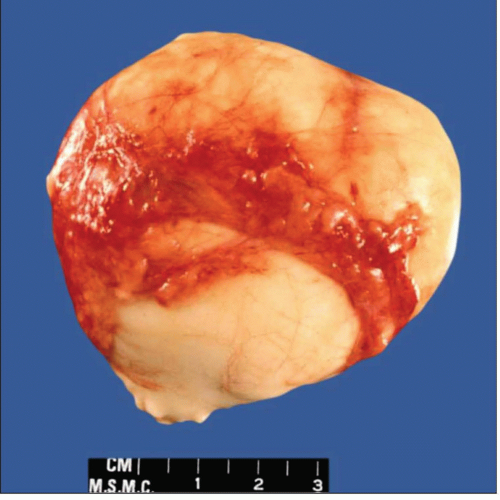Lymphangioma
Key Facts
Clinical Issues
Neck mass with extension into mediastinum (75% of patients)
Anterior mediastinal mass (15% of patients)
Cough
Dyspnea
Majority of patients are pediatric, < 2 years of age
Up to 50% of cases may be present at birth
Rapid enlargement of mass can be observed following upper respiratory tract infection that blocks lymphatic drainage
Surgery is usually curative
Image Findings
Large “soft” multicystic mass extending from neck into mediastinum
Variable size (range: 2-20 cm)
Usually large, cystic, with variable sized cysts
Lack of a capsule allows tumor to infiltrate surrounding tissues
Microscopic Pathology
Lesions may be of 3 types: Capillary, cavernous, or cystic lymphangioma
Composed of solid proliferation of small, capillary-sized lymphatic channels
Lymphoid aggregates present in stroma
Lumen of lymphatic spaces may be filled with clear proteinaceous fluid containing small lymphocytes
Walls of dilated lymphatic channels may show smooth muscle hyperplasia
Coalescence of dilated lymphatic channels leads to formation of large multicystic mass
 Gross appearance of cystic lymphangioma (cystic hygroma) in the anterior mediastinum of a child shows a well-circumscribed, distended cystic structure with a smooth and shiny outer surface. |
TERMINOLOGY
Synonyms
Cystic lymphangioma, cavernous lymphangioma, cystic hygroma, capillary lymphangioma
Definitions
Benign, tumor-like proliferation of lymphatic vessels
ETIOLOGY/PATHOGENESIS
Developmental Anomaly
Most likely represents hamartomatous process arising from sequestration of lymphatic tissue without connection to lymphatic system
May occur as congenital malformation of lymphatic vascular channels
CLINICAL ISSUES
Site
Neck mass with extension into mediastinum (75% of patients)
Anterior mediastinal mass (15% of patients); can also arise in posterior and middle mediastinum
May present as diffuse or multifocal process (lymphangiomatosis)
Presentation
Cough
Dyspnea
May be asymptomatic and discovered incidentally on routine chest x-ray
Rare tumor in mediastinum
Majority of patients are pediatric, < 2 years of age
Up to 50% of cases may be present at birth
Congenital cases can be associated with hydrops fetalis and Turner syndrome
Mass may enlarge, remain the same, or fluctuate in size over clinical evolution
Rapid enlargement of mass can be observed following upper respiratory tract infection that blocks lymphatic drainage
Treatment
Surgical excision
Some cases may respond to sclerotherapy with sclerosing agents
Prognosis
Surgery is usually curative
May show repeated recurrences after surgery and require multiple surgical interventions
IMAGE FINDINGS
General Features
Large, “soft” multicystic mass extending from neck into mediastinum
Variable size (range: 2-20 cm)
Smooth or lobulated mass with sharp margins
May be associated with chylothorax
Usually large, cystic, with variably sized cysts
Stay updated, free articles. Join our Telegram channel

Full access? Get Clinical Tree



